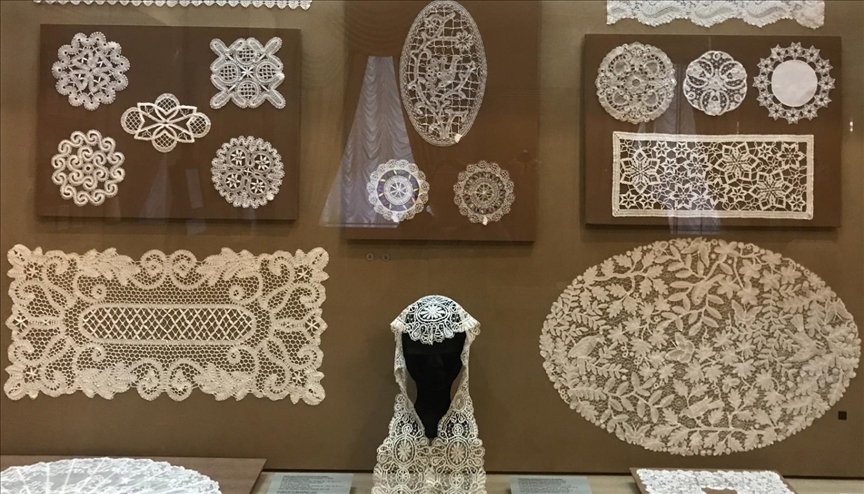What the history of Russian lace reveals about sanctions
As sanctions ramp up, the history of lace in Russia shows how scarcity can fuel unexpected innovations

- As sanctions ramp up, the history of lace in Russia shows how scarcity can fuel unexpected innovations
- Imported by royals, reinvented by artisans and preserved through centuries, lace reflects Russia’s history of adaptation
- ‘In the 17th century, lace was as desirable as today’s latest iPhone models,’ says Luisa Selyanina of the Vologda Lace Museum
MOSCOW
Russia’s relationship with the West has long fluctuated between cooperation and conflict, adopting foreign influences and then responding to embargoes. Few objects tell this story better than lace: once a banned European luxury, it was reinvented by Russian artisans into a national craft.
“Some may think that lace isn’t very important,” Luisa Selyanina, a senior researcher at the Vologda Lace Museum, told Anadolu. “But each century has its own luxury items. In the second half of the 17th century, lace was as desirable as today’s latest iPhone models.”
Lace first entered Russia in the 16th and 17th centuries from Italy, Flanders, and later France. “Western European royals and merchants introduced lace through diplomatic gifts, trade, and marriage alliances,” Selyanina said.
The delicate fabric, worn by Europe’s kings and nobles, soon captivated Russia’s tsars and aristocracy, who began importing it as a symbol of refinement. But political clashes repeatedly interrupted access. Then, as now, sanctions and embargoes became tools of power.
Lace under embargo
Emperor Peter the Great played a crucial role in popularizing lace in Russia, Selyanina explained. During his travels in Western Europe, he was deeply influenced by fashion and introduced sweeping reforms, including making lace a standard part of court dress for nobles.
“However, Peter fought with European countries a lot, which led to the ban on lace sales to Russia,” Selyanina said.
Cut off from European supply chains, Russia had to adapt, but the problem was limited access to cotton or silk – the main materials from which the lace was made in Europe.
Russia’s abundance of precious metals also inspired unique gold and silver threads.
“Today, rich people order their phones, cars, watches and other accessories made from gold and decorated with gems,” Selyanina said. “It’s the same way rich people wanted their laces made of gold many centuries before.”
Lacking imported teachers or manuals, artisans also had to invent their own techniques.
“Eventually, only the general idea of a delicate, ornamental fabric made by looping, twisting, or knitting threads into intricate, openwork patterns remained, while the means, ways and materials of its production changed,” she explained.
From cottage industry to cultural icon
Lace-making soon spread across towns and villages, often practiced by women in cottage industries supported by noble patrons and later by the state.
Cities such as Vologda, Yelets, Ryazan, Kostroma, Yaroslavl, and Tver became lace centers, each developing regional styles. Traditional Slavic motifs were woven into intricate patterns featuring recognizable local designs.
“By the 19th century, Russian lace was not just decorative; it became a symbol of national craftsmanship,” Selyanina said. “Some regions gained fame for their unique laces, and people traveled there from remote areas.”
Despite changing fashion trends, lace remained widely popular, especially as an integral part of festive clothes, bridal couture and undergarments.
“It is wonderful how lace, a delicate and fragile material, found its way through centuries, remaining resilient … and always finding its place in fashion,” she said.
Adapting to the ages
The Soviet Union nationalized lace workshops, ensuring production survived even amid ideological hostility to luxury. Instead of being condemned, lace was reframed as a folk craft.
“The Soviet time is another example of lace’s universality,” she said.
“The Soviet ideology ostracized everything that was considered a sign of the bourgeoisie. However, the simplicity and beauty of lace was accepted even by the fiercest critics of luxury goods.”
During this time, lace was also used to reflect the achievements of the state. Special limited editions of lace were produced on occasions like the victory in World War II and the first human spaceflight.
“Lace came to Russia from the courts of Europe to the fingertips of Russian artisans, wrapped in power, beauty, and a touch of imperial elegance. But gradually, it wove into the ordinary life of all people and bloomed into a distinct Russian tradition,” she said.
Now, as sanctions once again block the flow of foreign luxuries – from Paris couture to the most advanced microchips – Russia faces a familiar challenge. As its domestic industries are again being pressed to fill the gaps, the history of lace illustrates the results can be surprising.
And beyond Russia, China’s recent advances in generative artificial intelligence – with its powerful DeepSeek AI model – show how outside pressure continues to accelerate innovation in unexpected ways.
Anadolu Agency website contains only a portion of the news stories offered to subscribers in the AA News Broadcasting System (HAS), and in summarized form. Please contact us for subscription options.







